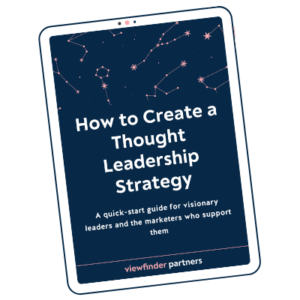One of the most common misconceptions about thought leadership is that the ideas have to be big, bold, and immaculately produced.
People stay in the shadows and keep their heads down because they’re too busy doing the work to cook up some big, fancy thought leadership campaign. Imposter syndrome takes over, and most people avoid thinking in public.
I disagree. Thought leadership doesn’t have to be a grand undertaking. You don’t need a team of writers and strategists in order to open up and share how you think about your work. Instead, I like to hear from people who know themselves, say what they mean, and don’t overthink it.
One way to be a thought leader is to actually say what you think. It’s rare and interesting because most of the “thought leadership” out there is very (very) boring. It’s white bread. It’s self-serving. It’s reviewed by layers of marketers and their bosses. It’s safe and on-brand. It’s not actually a way to build connections with other humans, and it’s not a way to spark new ideas. My advice: Talk like yourself! Say what you mean! Share your real reflections! Don’t overthink it.
Know yourself.
You may have seen me talk about “thought leadership strategy” and why it’s so important. So my advice to “just speak freely!” might seem counter-intuitive. What about the strategy?
So here’s the thing. Strategy is really about knowing yourself — getting clear on what you think and what’s important to you. Know your big-picture topic area. Know your core values. Investigate what you have learned and how your thinking has changed. Ask yourself about your vision for the future. If you know yourself, then you’ll stay centered on a steady fulcrum, no matter what ideas you explore.
I often point to Stephanie Nadi Olson as an example of a beacon – a leader who builds in public and thinks in public. Stephanie is fun for me to follow because she clearly knows herself and her values, and she’s not afraid to share them, even when her message challenges the status quo. It doesn’t feel like grandstanding or calculated marketing. It feels like a real person generously sharing what’s important to her.
Say what you mean.
You can be boldly refreshing just by being candid. Talk about your work like you’re talking to a friend or neighbor, not like you’re writing an academic report or giving a formal speech. Natural human language has propelled a lot of thought leaders.
It’s why marketers flock to anything by Ann Handley. It’s why I love listening to business podcasts that feel like I’m talking to a friend. (They Got Acquired has a beautiful show that makes stories about business acquisitions feel human and approachable.)
Don’t overthink it.
You don’t necessarily need a 6-month plan in order to start thinking in public. Think of your thought leadership as a playground or a lab. You’re experimenting to see what feels right, what sparks conversation, and what helps you explore your own ideas. Start small. Don’t overthink it. Take your ideas seriously. Take other people’s perspectives seriously. But don’t take yourself too seriously.
In my view, we’d have better conference stages, better social media feeds, and better Zoom meetings if more people followed this advice.
Know yourself. Say what you mean. Don’t overthink it.







